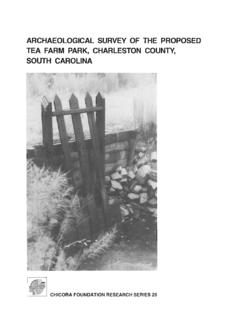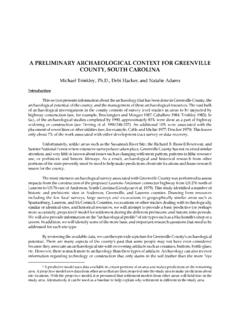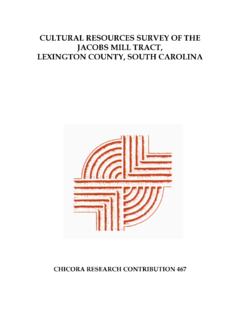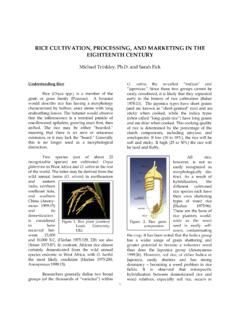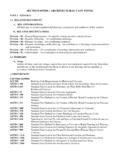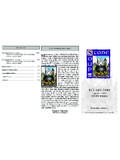Transcription of Chicora Foundation, Inc
1 Chicora Foundation, Inc. PO Box 8664 Columbia, SC 29202-8664 803/787-6910 REMOVING CLIMBING PLANTS FROM STONE AND MASONRY It is generally important to remove heavy vegetation from stone and masonry, as its presence can pose a wide-variety of preservation problems, including: holding moisture against the surface scouring soft surfaces eroding mortar joints, and hindering or limiting access for inspections and repairs. Supplies and Equipment Herbicides generally include a range of salts that will adversely affect stone and masonry. As a result, their use on stone or masonry is strongly discouraged. In this procedure the herbicide is applied only to the vine trunk and never to the stone or surrounding soil. The items you will need include: commercial brush killer, such as Chevron s Brush-B-Gon or Monsanto s Round-Up, lopping and/or pruning shears, a sharp knife, a small paint brush, garden hose and nozzle, soft bristle brushes (non-metallic), and wood scrapers, such as tongue depressors and/or popsicle sticks.
2 Procedure to Remove Vines First, carefully examine the vegetation and stone or masonry surface (such inspections should be done periodically throughout the growing season to prevent future problems). Check to see if the vine roots have penetrated the stone or masonry. If masonry joints, the masonry itself, or the stone is found to be deteriorated due to the roots or because of the weight of the plant itself, you will need to consult with a conservator do not attempt to remove the vegetation yourself. If the vine has not yet damaged the masonry or stone, the following procedure should be followed. Use lopping or pruning shears to cut the vine trunk about 4-inches above grade and remove a section of stem about 6-inches in length above this cut (in other words, you will create about a 6-inch gap between the stump of the trunk and the stem of the plant). Make vertical cuts through the bark of the stump and peel the bark back slightly to expose about 1-inch of the inner wood.
3 Paint the brush killer directly on the surface and sides of the stump. Be careful not to get any on the stone or masonry surface or the ground surface. This will kill the root system and help prevent the vine from resprouting. Allow the vine to die naturally, then remove the dried tendrils and roots, taking care not to remove or damage any stone or masonry. Never pull or yank the vines off this is almost certain to damage the 1 2 fragile historic fabric of the masonry or stone. Coax or ease the plant material off the wall using wooden scrapers. Often water will help loosen the plant material. If the vine was very large, it may be necessary to cut the network of stems into smaller sections. Be careful not to allow the material you re removing fall or cause additional damage. Also be certain to gather all of the debris up and remove them from the cemetery. It is best not to leave dead wood in wall joints. As the wood decays the void it creates that will lead to additional, and often even more serious problems.
4 If the vines were large, it may be necessary to conduct repairs on the wall or stone consult a conservator for advice on this problem. After removing as much material as possible, gently scrub the surface with a soft, non-metallic bristle brush and clean, potable water (sprayed at low pressure). This will help remove the last of the vegetation. Special Problem Plants Poison Ivy This is a common plant in cemeteries that have been abandoned or where maintenance has been minimal. Its control, while difficult, can be achieved through either mechanical or chemical means. Mechanical control eliminates the need for chemicals, but does expose those involved to the plant s chemical that causes rashes, blisters, and itch urushiol. That means if you decide to manually remove the plant, all potentially exposed skin must be covered and extreme care should be taken to prevent the spread of the oil to other family clothes through washing. Grubbing or pulling can eliminate poison ivy.
5 The real advantage to this approach is that it can be used in areas where chemicals can t be applied because of other valuable plants. Pulling is easier and more effective after heavy watering, allowing you to pull out much of the root system. Leave as little as possible in the ground since large root sections will sprout vigorously later. There are a number of recommended chemicals for controlling poison ivy. These include 2,4-D, triclopyr, MCPP, glyphosate, and dicamba. Glyphosate (Round-Up or Kleen-Up) is moderately effective for killing poison ivy, translocating throughout the plant and eventually killing both leaves and roots. It, however, is non-selective and will kill or severely injure most kinds of plants contacted by the spray. Dicamba is most effective when mixed with 2,4-D and MCPP, resulting in a mixture called Trimex. A complete kill may require two to three applications over the course of a growing season or during successive years.
6 Ortho Poison Ivy Killer (triclopyr), if used sparingly, will kill poison ivy but not trees it grows around. Nevertheless, it is usually best to use the procedure described above for killing vines when poison ivy has taken over a tree. The FDA has a good poison ivy web page that provides identification, control, and medical information. While there are lots of home remedies for poison ivy exposure, one of the best we ve found is the product Tecnu -- a wash designed to remove the urushiol. Additional information is available at Kudzu There is no question that kudzu is one of the most difficult plants to control roots can descend 16 feet into sandy loams and the plant spreads aggressively (growing at a rate of one-foot a day in the early summer). The plant withstands even heavy freezes. While it doesn t establish itself in healthy grass cover, it may spread into such areas by running vines. It can quickly take over an abandoned rural 3 cemetery and can even pose a significant threat in urban areas.
7 All experts agree that total eradication of kudzu is necessary to prevent re-growth. You must be persistent, accepting that control will require a multi-year program. Part of this program must include re-vegetation to ensure that residual kudzu doesn t reestablish. In addition, if the kudzu is on adjacent property it is critical that you enlist the assistance of those property owners as well control will require a unified program. In cases of light or very recent infestation control can be achieved over 3-4 years by digging out the roots or by persistently cutting back the vegetation during the hottest temperatures of summer. Plants that persist after 4 years can be easily controlled using herbicides. Old, thick infestations are far more difficult to control and herbicides are almost always necessary. Best results from chemical treatment occur if the application is done in the late summer, when flowers appear and nutrients are being actively transported to the roots.
8 Although most herbicides will kill back the stems and leaves of kudzu, most will not provide effective eradication, leaving the root systems intact. Testing has provided these recommendations: Tordon 101 Mixture (2,4-D + picloram) and Tordon K (picloram liquid) are the most cost-effective herbicides. Both need to be applied as foliar sprays that should then be washed from the leaves to the ground by either rainfall or spray irrigation of less than 1-inch within 2 to 5 days after application. Treatment should be done no earlier than late June or July. The recommended rate of Tordon 101 is 2 gallons per acre or 40 gallons of spray mixture per acre. Thorough coverage is essential and spraying should be done using a cross-hatch pattern to ensure that all plants are soaked. At least one retreatment will be required two years after the initial application. Tordon will harm non-target plants and is very water soluble. It is also relatively persistent in the environment.
9 As a result, it is a restricted use herbicide, so you will need to hire a landscape firm with a pesticide license to do this work. It can kill new plants introduced into the treated area too soon after application, although many grasses are not affected. Several chemicals such as Spike 20P (pellets) and Spike 80W (wettable powder) (both tebuthiruon) are used in non-crop areas, such as fencerows and rights-of-way. These may be suitable for some cemetery areas. These are non-selective and will kill all vegetation in the treated area, so they are certainly a last resort. For sensitive areas chemicals such as Roundup and Rodeo (glyphosate) or Transline (clopyralid) have been used. While much less stressful on the environment, these have also proven to be relatively ineffective against established kudzu (for example, Roundup has been found to be only 64% effective after 2-years of application). While often not possible, this discussion should illustrate that the best control mechanism for kudzu is simply not to allow it to become established.
10 Unfortunately, in many cemeteries this is no longer an option. We recommend that you consult with both your local agricultural extension agent and also a stone conservator to develop an approach that is most likely to provide control. Just remember, it took years for the kudzu to become well established it s going to take years to bring it under control. The best web site we ve found on kudzu control is


